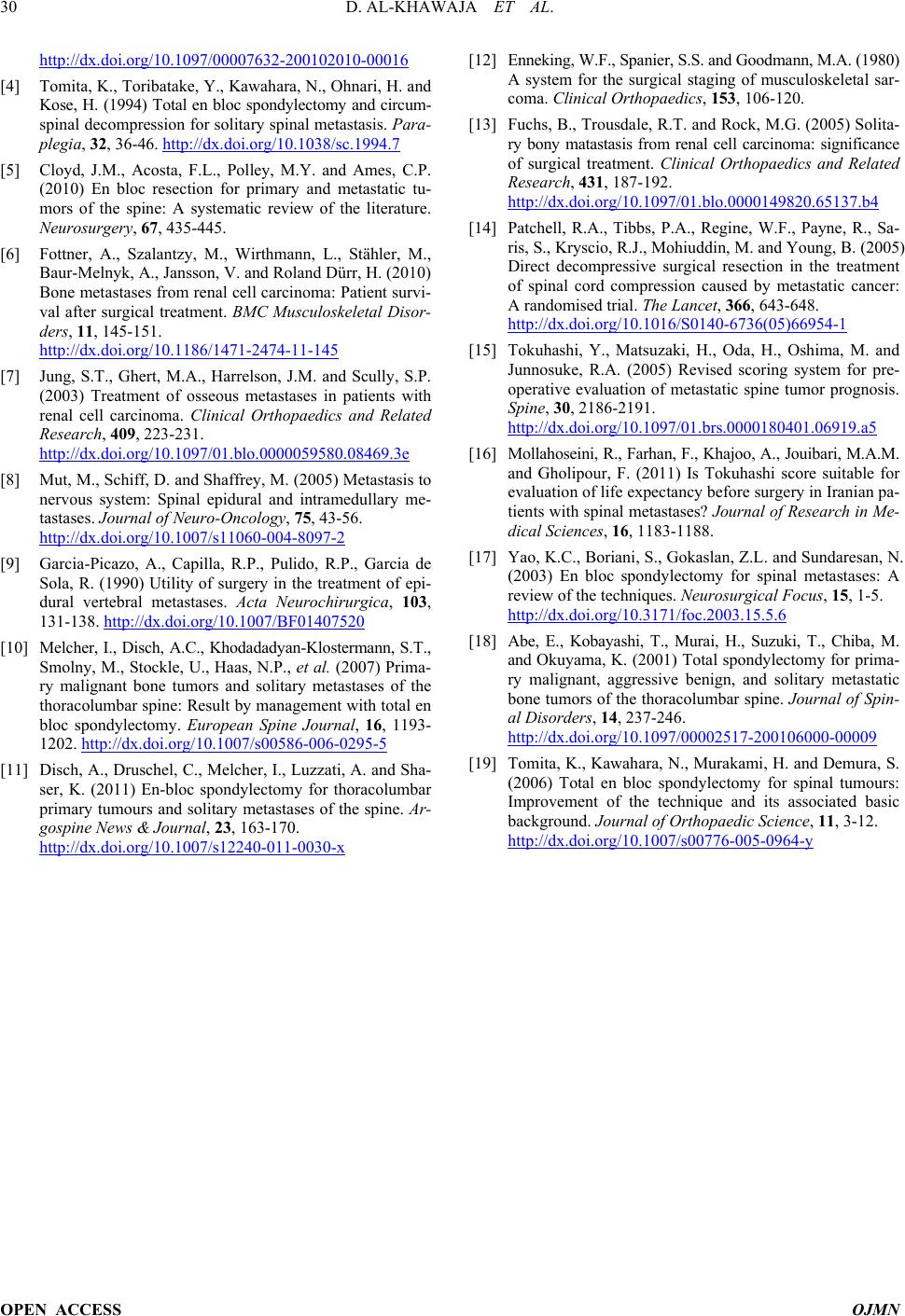
D. AL-KHAWAJA ET AL.
OPEN ACCESS OJMN
http://dx.doi.org/10.1097/00007632-200102010-00016
[4] Tomita, K., Toribatake, Y., Kawahara, N., Ohnari, H. a nd
Kose, H. (1994) Total en bloc spondylec tomy and circu m-
spinal decompression for solitary spinal metastasis. Para-
plegia, 32, 36-46. http://dx.doi.org/10.1038/sc.1994.7
[5] Cloyd, J.M., Acosta, F.L., Polley, M.Y. and Ames, C.P.
(2010) En bloc resection for primary and metastatic tu-
mors of the spine: A systematic review of the literature.
Neurosurgery, 67, 435-445.
[6] Fottner, A., Szalantzy, M., Wirthmann, L., Stähler, M.,
Baur-Melnyk, A., Jansson, V. and Roland Dürr, H. (2010)
Bone metastases from renal cell carcinoma: Patient survi-
val after surgical treatment. BMC Musculoskeletal Disor-
ders, 11, 145-151.
http://dx.doi.org/10.1186/1471-2474-11-145
[7] Jung, S.T., Ghert, M.A., Harrelson, J.M. and Scully, S.P.
(2003) Treatment of osseous metastases in patients with
renal cell carcinoma. Clinical Orthopaedics and Related
Research, 409, 223-231.
http://dx.doi.org/10.1097/01.blo.0000059580.08469.3e
[8] Mut, M., Schiff, D. and Shaffrey, M. (2005) Metastasis to
nervous system: Spinal epidural and intramedullary me-
tastases. Journal of Neuro-Oncology, 75, 43-56.
http://dx.doi.org/10.1007/s11060-004-8097-2
[9] Garcia-Picazo, A., Capilla, R.P., Pulido, R.P., Garcia de
Sola, R. (1990) Utility of surgery in the treatment of epi-
dural vertebral metastases. Acta Neurochirurgica, 103,
131-138. http://dx.doi.org/10.1007/BF01407520
[10] Melcher, I., Disch, A.C., Khodadadyan-Klostermann, S.T.,
Smolny, M., Stockle, U., Haas, N.P., et al. (2007) Prima -
ry malignant bone tumors and solitary metastases of the
thoracolumbar spine: Result by management with total en
bloc spondylectomy. European Spine Journal, 16, 1193-
1202. http://dx.doi.org/10.1007/s00586-006-0295-5
[11] Disch, A., Druschel, C., Melcher, I., Luzzati, A. and Sha-
ser, K. (2011) En-bloc spondylectomy for thoracolumbar
primary tumours and solitary metastases of the spine. Ar-
gospine News & Journal, 23, 163-170.
http://dx.doi.org/10.1007/s12240-011-0030-x
[12] Enneking, W.F., Spanier, S.S. an d Goodmann, M.A. (1980)
A system for the surgical staging of musculoskeletal sar-
coma. Clinical Orthopaedics, 153, 106-120.
[13] Fuchs, B., Trousdale, R.T. and Rock, M.G. (2005) Solita-
ry bony matastasis from renal cell carcinoma: significance
of surgical treatment. Clinical Orthopaedics and Related
Research, 431, 187-192.
http://dx.doi.org/10.1097/01.blo.0000149820.65137.b4
[14] Patchell, R.A., Tibbs, P.A., Regine, W.F., Payne, R., Sa-
ris, S., Kryscio, R.J., Mohiuddin, M. and Young, B. (2005)
Direct decompressive surgical resection in the treatment
of spinal cord compression caused by metastatic cancer:
A randomised trial. The Lancet, 366, 643-648.
http://dx.doi.org/10.1016/S0140-6736(05)66954-1
[15] Tokuhashi, Y., Matsuzaki, H., Oda, H., Oshima, M. and
Junnosuke, R.A. (2005) Revised scoring system for pre-
operative evaluation of metastatic spine tumor prognosis.
Spine, 30, 2186-2191.
http://dx.doi.org/10.1097/01.brs.0000180401.06919.a5
[16] Mollahoseini, R., Farhan, F., Khajoo, A., Jouibari, M.A.M.
and Gholipour, F. (2011) Is Tokuhashi score suitable for
evaluation of life expectancy before surgery in Iranian pa-
tients with spinal metastases? Journal of Research in Me-
dical Sciences, 16, 1183-1188.
[17] Yao, K.C., Boriani, S., Gokasl an, Z.L. a nd Sundaresan, N.
(2003) En bloc spondylectomy for spinal metastases: A
review of the techniques. Neurosurgical Focus, 15, 1-5.
http://dx.doi.org/10.3171/foc.2003.15.5.6
[18] Abe, E., Kobayashi, T., Mura i, H., Suzuki, T., Chiba, M.
and Okuyama, K. (2001) Total spondylectomy for prima-
ry malignant, aggressive benign, and solitary metastatic
bone tumors of the thoracolumbar spine. Journal of Spin-
al Disorders, 14, 237-246.
http://dx.doi.org/10.1097/00002517-200106000-00009
[19] Tomita, K., Kawahara, N., Murakami, H. and Demura, S.
(2006) Total en bloc spondylectomy for spinal tumours:
Improvement of the technique and its associated basic
background. Journal of Orthopaedic Science, 11, 3-12.
http://dx.doi.org/10.1007/s00776-005-0964-y